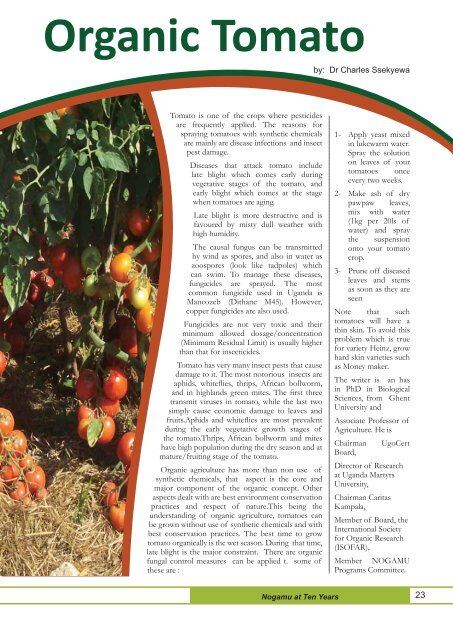Newsletter issue 33 - Nogamu
Newsletter issue 33 - Nogamu
Newsletter issue 33 - Nogamu
Create successful ePaper yourself
Turn your PDF publications into a flip-book with our unique Google optimized e-Paper software.
Organic Tomato<br />
by: Dr Charles Ssekyewa<br />
Tomato is one of the crops where pesticides<br />
are frequently applied. The reasons for<br />
spraying tomatoes with synthetic chemicals<br />
are mainly are disease infections and insect<br />
pest damage.<br />
Diseases that attack tomato include<br />
late blight which comes early during<br />
vegetative stages of the tomato, and<br />
early blight which comes at the stage<br />
when tomatoes are aging.<br />
Late blight is more destructive and is<br />
favoured by misty dull weather with<br />
high humidity.<br />
The causal fungus can be transmitted<br />
by wind as spores, and also in water as<br />
zoospores (look like tadpoles) which<br />
can swim. To manage these diseases,<br />
fungicides are sprayed. The most<br />
common fungicide used in Uganda is<br />
Mancozeb (Dithane M45). However,<br />
copper fungicides are also used.<br />
Fungicides are not very toxic and their<br />
minimum allowed dosage/concentration<br />
(Minimum Residual Limit) is usually higher<br />
than that for insecticides.<br />
Tomato has very many insect pests that cause<br />
damage to it. The most notorious insects are<br />
aphids, whiteflies, thrips, African bollworm,<br />
and in highlands green mites. The first three<br />
transmit viruses in tomato, while the last two<br />
simply cause economic damage to leaves and<br />
fruits.Aphids and whiteflies are most prevalent<br />
during the early vegetative growth stages of<br />
the tomato.Thrips, African bollworm and mites<br />
have high population during the dry season and at<br />
mature/fruiting stage of the tomato.<br />
Organic agriculture has more than non use of<br />
synthetic chemicals, that aspect is the core and<br />
major component of the organic concept. Other<br />
aspects dealt with are best environment conservation<br />
practices and respect of nature.This being the<br />
understanding of organic agriculture, tomatoes can<br />
be grown without use of synthetic chemicals and with<br />
best conservation practices. The best time to grow<br />
tomato organically is the wet season. During that time,<br />
late blight is the major constraint. There are organic<br />
fungal control measures can be applied t. some of<br />
these are :<br />
1- Apply yeast mixed<br />
in lukewarm water.<br />
Spray the solution<br />
on leaves of your<br />
tomatoes once<br />
every two weeks.<br />
2- Make ash of dry<br />
pawpaw leaves,<br />
mix with water<br />
(1kg per 20ls of<br />
water) and spray<br />
the suspension<br />
onto your tomato<br />
crop.<br />
3- Prune off diseased<br />
leaves and stems<br />
as soon as they are<br />
seen<br />
Note that such<br />
tomatoes will have a<br />
thin skin. To avoid this<br />
problem which is true<br />
for variety Heinz, grow<br />
hard skin varieties such<br />
as Money maker.<br />
The writer is an has<br />
in PhD in Biological<br />
Sciences, from Ghent<br />
University and<br />
Associate Professor of<br />
Agriculture. He is<br />
Chairman UgoCert<br />
Board,<br />
Director of Research<br />
at Uganda Martyrs<br />
University,<br />
Chairman Caritas<br />
Kampala,<br />
Member of Board, the<br />
International Society<br />
for Organic Research<br />
(ISOFAR),<br />
Member NOGAMU<br />
Programs Committee.<br />
<strong>Nogamu</strong> at Ten Years<br />
23


